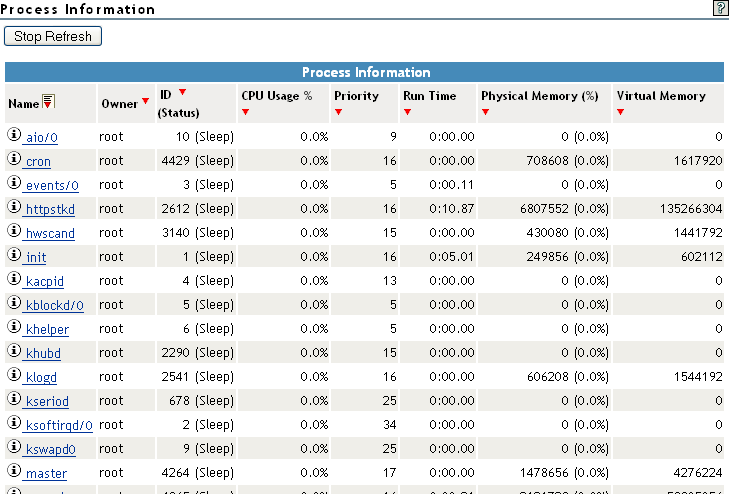10.5 Managing Processes
Clicking the View Process Information link in the navigation frame displays the Process Information page. On this page, you can view a list of all the processes as well as their state in the host and perform the actions listed in the following table.
Table 10-5 Process Information Page Tasks and Procedures
|
Tasks |
Procedures |
|---|---|
|
Sort the process by name (in alphabetical order by default), by process ID, by CPU Usage, or by Memory Usage |
Click the Sort icon |
|
View more specific information about a listed process |
Click the link for the applicable process under the Name column. |
|
Kill a process |
|
The process information is obtained from the stat file that is available for each process ID in the /proc directory. Process information can also be retrieved at the command line by using the Linux top command.
Table 10-6 describes the parameters reported for each process.
Table 10-6 Process Information
|
Parameter |
Description |
|---|---|
|
Name |
The process name. |
|
Owner |
The process owner; the user who started the process. |
|
ID (Status) |
The process ID of the task, and the current state of the task. The states are Sleep (S), Running (R), Traced (T), or Zombied (Z). These states are modified by a trailing < for a process with a negative nice value, N for a process with positive nice value, and W for a swapped-out process (this does not work correctly for kernel processes). |
|
CPU Usage % |
The task's share of the CPU time since the last screen update, expressed as a percentage of total CPU time per processor. |
|
Priority |
The priority of the task. |
|
Run Time |
The total CPU time the task has used since it started. |
|
Physical Memory |
The physical memory value is the amount of physical memory in bytes that the task is using. The value in parentheses (%) is the percentage of RAM memory that this represents. The Linux top command reports this information in kilobytes. |
|
Virtual Memory |
The virtual memory is the amount of memory in bytes that the task is using to hold the code, data, and stack space memory. The Linux top command reports this information in kilobytes. Virtual Memory is the value reported by the RSS switch for the top command. |
Figure 10-5 Example Process Information Page

 at the top of the applicable column.
at the top of the applicable column.